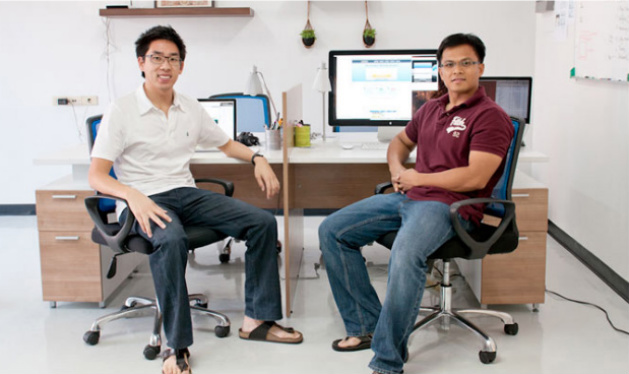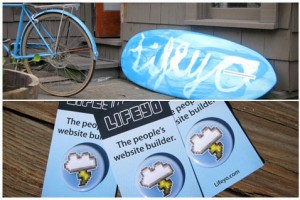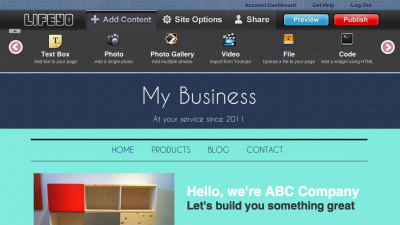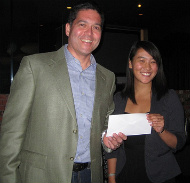BY STEFFI LAU, USC senior/ 2010-2011 AAJA Scholarship Winner
Unlike most tech start-up founders, AAJA member Mike Kai’s story began with a foray into journalism as a teenager.
Kai, 28, is the CEO and founder of LIFEYO, a website creation platform that has been in development for the past three years. The site was launched in beta a year ago, and by word of mouth, more than 20,000 sites already have been created through LIFEYO. It just launched its latest version this month. LIFEYO aims to simplify the website-building experience, with drag-and-drop features, allowing users to customize content and create a site within minutes.
“The Internet allows people to participate in media different from traditional media,” Kai said. “With the Internet, everything is a lot faster. Everyone talks about how fast Twitter is, but fast to me is the ability to get a website up and running through a website like LIFEYO and focus on an idea you have.”


At first glance, it might not seem like LIFEYO, a website hosting platform and AsianConnections.com, an online magazine focusing on Asian Americans and East Asians doing interesting things, have much in common. But on the contrary, the two are very much intertwined and in fact, one might not exist without the other.
“(AsianConnnections) kind of kicked off that direction in life for me,” said Kai, who started the website in 1998. “When I was 15, the Internet was very new and the idea of blogging hadn’t come up yet, but I decided to build this website. It was basically this really cool opportunity for a kid to call up Jackie Chan’s publicist and land an interview and go on to cover really cool people.”
Kai’s mom, AAJA-LA board member Suzanne Joe Kai, one of the first Asian American women to become a broadcast television personality, got involved and mentored Kai in journalism.
Kai says he started the site to provide a broader perspective on Asian Americans.
“I felt that often Asian characters are typecast in the media and yet there are a lot of great stories that aren’t being told,” he said.
The ease of creating online content has led to more opportunities to cover angles not being told in mainstream media, particularly in regards to Asian American and minority perspectives.
“In minority journalism, there’s a lot of stories that aren’t being told in traditional media, but you have the opportunity to fill that void,” Kai said. “To me, that’s what’s really exciting—you have a choice of where to find news, not just relying on traditional sources, and also the choice to create content. The ability to participate is just getting easier and easier.”
Today, Kai is no longer involved in the day-to-day operations of AsianConnections, which is still up and running and is now run by his mom, who he says it’s a “labor of love.” The site, currently undergoing a major system upgrade, has a number of contributors since its inception, including Ben Fong-Torres, author and rock journalist who wrote for Rolling Stone, and Chef Martin Yan, author and host of PBS series “Yan Can Cook.” The site produced a live chat with action star Jet Li with Warner Bros. U.S. Astronaut Leroy Chiao blogged about his experiences while orbiting the Earth as Commander of the International Space Station.
As a teenager, the experience creating the website brought to life the power of the Internet to make unheard voices heard.
“The biggest lesson I learned is that basically when you have an idea and you’re driven by something meaningful to you, you should pursue it,” Kai said. “For me, the mission to go out and present Asian actors or chefs or restaurant owners in a way that’s very open, that was something I cared a lot about and I was very fortunate the Internet came around the same time I was growing up where it was something I could create and people would take it seriously.”
For Kai, the venture is not just another business, but a chance to allow others to easily create content and have their voices heard, just as he did as a teen.
“Web development has changed a lot with people being able to create a persona on Facebook, yet building a site is still a pretty extensive process. If you don’t have that knowledge, you need to hire someone and once you do have a website, it’s challenging to keep the site updated,” Kai said. With technologies more available in the web browser, we had opportunity to build a product really easy to use.”
The lessons Kai learned as a teenager creating and running AsianConnections are the motivating force behind his work life today.
“I feel very fortunate that having that experience opened up a big world I didn’t even know existed,” Kai said. “In creating LIFEYO, we wanted to create a way for people to get an idea out there in just a few clicks whether they’re a journalist, have a business, or just want to share a family web site. It’s a very powerful thing to be able to get content online and that’s what we’re driven by right now.”
CONTACT: MIKE KAI — MIKE@LIFEYO.COM
Q&A

Why did you decide to create LIFEYO?
I basically felt there was a big need for people to have a tool that’s easy to use and that allows them to share content. We identified that there’s 500 million people using Facebook. At the same time, a lot of these people are learning to use social media and a lot of these people are taking the next step and making websites. It lets you control your brand and take ownership. It’s great if you are looking for a job or have a hobby and want to share content.
What kind of things do people use LIFEYO for?
One of the ways people use it is to have a personal, professional page for themselves. It’s a great way to have your resume online. It lets you create an online personal persona and gives you a lot more control so you can present yourself in a professional way. Especially for someone who does creative work, having a website is great way to share selections with potential employers.
What is the goal of LIFEYO?
With the Internet, there’s literally no telling, for us. Our main priority is creating a product so easy to use that people want to share it with their friends. We find that when people are successful creating websites, they want to go share it with their friends. The need to have a website is pretty universal across multiple professions.
What makes LIFEYO different from other web platforms?
We’re really not trying to reinvent the wheel. The need for easy website creation has been around a long time. You don’t need to download any software, everything operates within the browser. When you compare LIFEYO to Tumblr or Blogger, the thing we try to focus on is making the design process of the site very streamlined and giving people a lot of flexibility in making your design your own.
We offer a blogging tool that lets people keep their site fresh and updated, but it also lets you add additional pages, so can have a photo gallery, contact form, you can easily integrate it with Facebook, embed videos from YouTube, have Google Maps, anything you can think of.
What can journalists learn from web developers?
For journalists, especially for journalists just starting off, they want to create a brand, they want to create something people feel has quality content. But sometimes what is overlooked is the experience accessing the content and how it is portrayed visually. If I’m a journalist and want to blog, I could just go to Blogspot and get the same template that everyone else has, but that doesn’t necessarily portray my hard work in the best way. From a web design standpoint, branching away from your basic Facebook or Twitter account is a big step forward in having a web presence you can manage.
How did you come up with the name?
I didn’t want to create something that dictated what people want to produce and the most all-encompassing aspect I could think of to reflect that was “life.” I just added “yo” because it added that fun aspect, it was easy to spell, short and tongue-in-cheek.
A CENTURY ON, RE-ENVISIONING A 21st CENTURY RAFU SHIMPO: Samantha Masunaga (Peter Immamura Memorial Scholarship recipient/ UCLA junior) talks to editors at the largest and oldest Japanese daily newspaper about grappling with a changing newspaper industry.
‘GRADING THE TEACHERS’: 100 interviews later…: Sonali Kohli (AAJA-LA scholarship winnner/ UCLA sophomore) interviews education reporter Jason Song about preparing the 2010 LA Times series on value-added analysis.
PATCHING UP THE JOURNALISM INDUSTRY: Natasha Zouves (Sam Chu Lin scholarship winner/ USC junior) interviews AAJA-LA members Patrick Lee (regional editor, LA) and Hazel Lodevico To’o (glendora.patch.com) about working for AOL-owned Patch.


